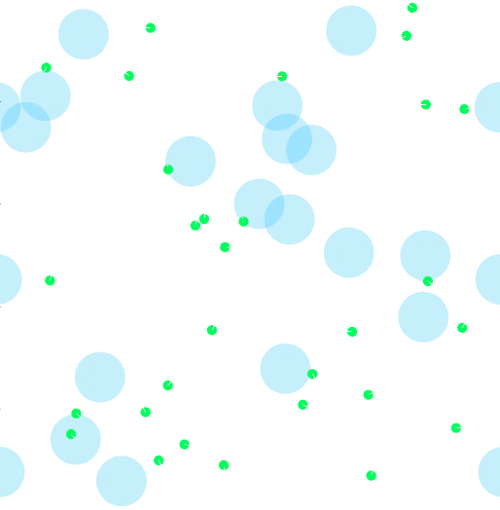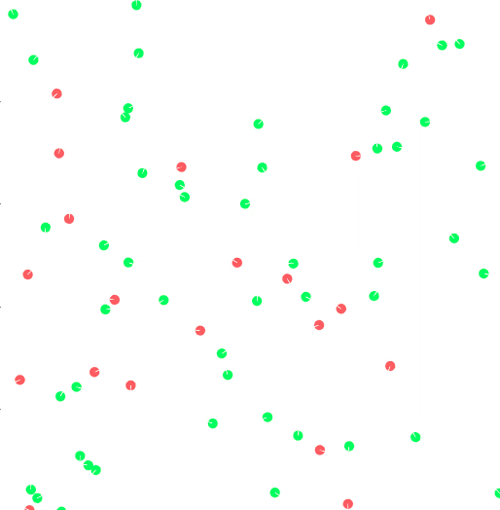Character Vision
One of the vital character parameters is the vision. The vision object creates a set of rays oriented at different angles on either side of the characters orientation. The user can provide the center of these group of rays, and the total field of view. IE, if the user provides a FOV of 90 degrees, offset of 45 degrees, and 9 rays, the rays will all have a width of 10 degrees, and the "left" rays will be centered on (left to right) [85,75,65,55,45,35,25,15,5] degrees, and the "right" rays centered on [355,345,335,325,315,305,295,285,275] degrees. Any named object that the character can see that intersects one of these rays will be placed within it, and the closest values are used to determine changes in behavior.
With the vision object, we can pair it with a Multi Layered Perceptron to train the predator and prey behavior, by outputting changes to speed and orientation as the final layer. We do this using a simple MLP to ensure we capture intended behavior or turning towards food, avoiding collisions, and avoiding predators. We later those combine those with a MLP to construct a much stronger neural network that can weigh these decisions against each other.
Training Simple Behavior
We first use reinforcement learning to train basic behavior into our characters. The most obvious of these is to encourage our characters to move towards food. In the case of prey, this is the static food sources. We devise a rule set based on the following principles:
- If there is no food visible, turn slightly and increase speed to find it.
- If there is food in our heading, increase speed towards the food.
- If there is no food in our heading and food slightly off our heading, turn towards it.
- If there is no food near our front but food to the side, decrease speed and turn towards it.

We do see the desired behavior. There is some funny circling that can occur if the food source is hit from a slight angle, but this is ok. We don't want to sit stationary in the food source, as we want to give opportunity to see predators. There is a clear problem however with collisions, which we don't want. So, on to our next behavior test.
We want to avoid collisions, so we must train behavior to avoid similar characters when we will collide. This is a simpler rule set:
- If there is a character of the same name very close and in our heading, turn away and heavily decrease speed.
- If there is a character of the same name very close and not in our heading, turn away.

Success! These results clearly show cases of the prey avoiding other prey.
Finally, we arrive at the final simple behavior to test - flee from predators. These rules are:
- If our predator is in our heading, heavily decrease speed and turn hard.
- If our predator is near our heading, decrease speed and turn hard.
- If our predator is near 45 degrees from our heading, turn.
- If our predator is greater than 45 degrees from our heading, turn and speed up.

Another successful test! We use dummy predators in red that move at a constant speed, and see the prey reacting to the presence of predators in their vision.